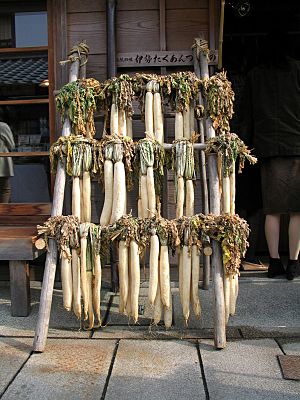Japanese radish facts for kids
Quick facts for kids Japanese radish (true daikon) |
|||||||||
|---|---|---|---|---|---|---|---|---|---|

radishes in Okage Yoko-chō, Japan
|
|||||||||
| Chinese name | |||||||||
| Traditional Chinese | 日本蘿蔔 | ||||||||
| Simplified Chinese | 日本萝卜 | ||||||||
| Literal meaning | "Japanese radish " | ||||||||
|
|||||||||
| Korean name | |||||||||
| Hangul | 왜무 | ||||||||
| Literal meaning | Wae radish | ||||||||
|
|||||||||
| Japanese name | |||||||||
| Kanji | 大根 | ||||||||
| Kana | だいこん | ||||||||
|
|||||||||
The word Daikon (pronounced dye-kon) comes from the Japanese language. It literally means "big root." It's a general term for any type of radish in Japan. For example, the smaller, round European radish is called hatsukadaikon in Japan.
In other parts of the world, especially in the West, when people say daikon, they usually mean the long, white Asian radish varieties. Sometimes, they specifically mean the kinds grown in Japan. If you need to be super clear, you might hear it called "Japanese radish" or "true daikon."
Different Kinds of Daikon
There are many different kinds of daikon radishes, each with its own unique shape and size.
Common Japanese Daikon
The most common type of daikon in Japan is called aokubi-daikon. This radish has a long, white root that looks a bit like a giant carrot. It usually grows to be about 20 to 35 cm (8 to 14 in) long and 5 to 10 cm (2 to 4 in) wide. Many daikon varieties found in China and India are quite similar to this common Japanese type.
Giant Sakurajima Radish
One of the most amazing daikon varieties is the Sakurajima radish. It's grown near Kagoshima in Japan. This radish is shaped like a turnip and can grow to be incredibly huge! Some Sakurajima radishes can reach up to 50 cm (20 in) across and weigh as much as 45 kg (100 lb). That's like carrying a small child!


